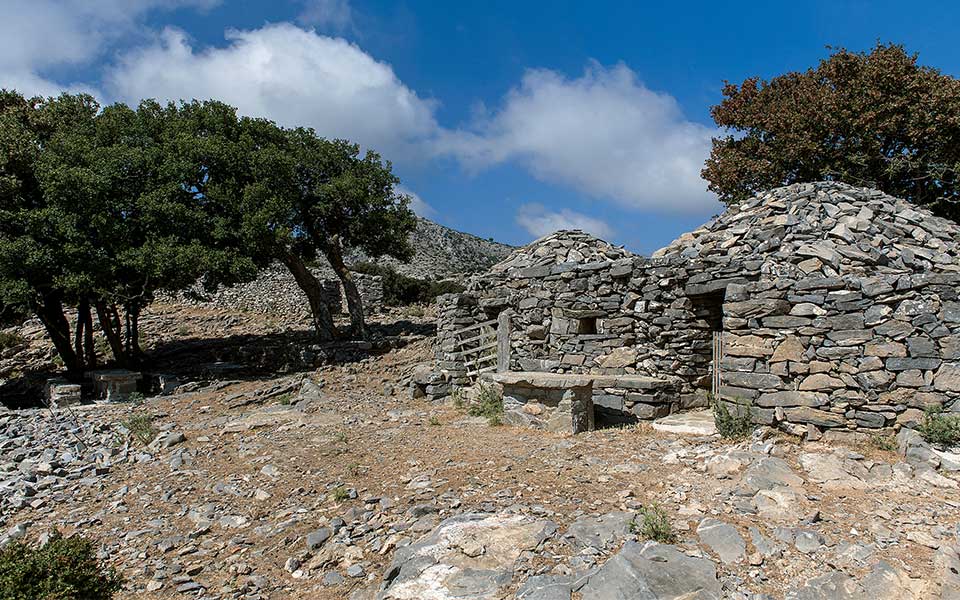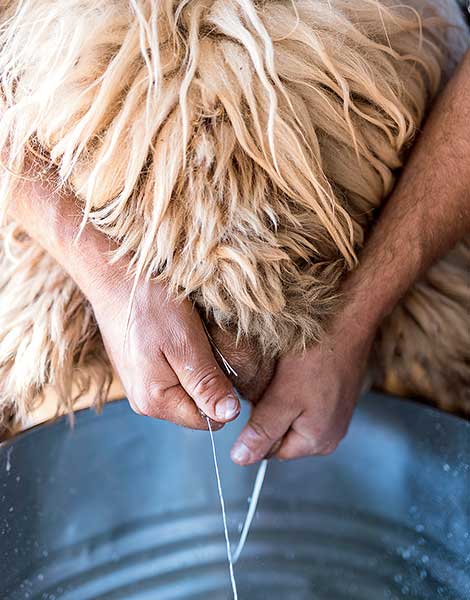Mitata (sing. mitato) is the Cretan name for the rudimentary shepherds’ dwellings built in the mountains and, since one of their principal uses is to store and age cheese, they’re often considered to be the earliest form of dairies in the country. These stone structures symbolize the first stage of what later grew into a great tradition of dairy farming in Crete.
Most of the mitata in the region of Rethymno are concentrated on the Nida Plateau and in Livadia, high up on the slopes of Mt Psiloritis. This is where shepherds would spend their summers – alone, except for their animals and other passing shepherds. Being so remote, the mitata were also used as hideouts during the Ottoman occupation; during the Second World War, they provided cover for resistance fighters. These shelters, built of locally-sourced stones and shaped like Minoan tholos tombs, have entrances that face due east and, although they’re unique to Crete, somewhat similar structures can be found in other parts of the Mediterranean as well. Each one was surrounded by a drystone wall about 1.5m high, which was used as a corral to gather sheep and goats for milking. Made of nothing but stone on stone, the mitata continue to stand on the mountain rock as examples of perfect vernacular architecture – modest, sturdy and functional in the extreme. Larger, squarer stones were placed at the bottom in a circle, with the stones at the top being carved into shape. The structures became narrower as they grew taller, much like an igloo, in order to stand the weight of the winter snow. The gaps between the stones were deliberately not filled in with clay or any other material, in order to allow air to pass through the walls to dry out the cheese, maturing it in the process. A small window – like a skylight – was left at the top of the dome, where spiders would be able to weave a nice thick web, catching flies and other insects and keeping them away from the cheese: a brilliant example of man and insect working together in symbiosis.

© Thalia Galanopoulou

© Thalia Galanopoulou
THE BIRTH OF CHEESE
High up in the mountains, shepherds and goatherds would take the milk from their flocks straight to the cauldron in the mitato. Some of the shelters had two domes or two rooms to separate the processes of preparation and ageing. Standard items and utensils found here included the toupakia (straw baskets used as molds for fresh cheese); pots and ladles for the cheesemaking itself; a pan or a pot where the shepherds would cook their food; a katsouna (shepherd’s crook) and some rudimentary form of bedding. Some would have family photographs on the walls to keep them company and to add a note of joy to their otherwise drab surroundings.
Coming straight from the udder, the milk was already warm when it was poured into the hot cauldron and treated with rennet, an enzyme found in the stomachs of young ruminants that allows them to digest milk. Since there were no laws mandating the use of pasteurized milk in the past, the cheeses that came out of these traditional dairies were quite harsh in taste, with relatively intense and aggressive flavors. “Hole cheeses,” made with unpasteurized milk, are particularly treasured, so called because the natural fermentation process and lengthy ageing create large holes in their surface.
Most of Crete’s surviving mitata have been around for at least several decades. Many of them have been abandoned and no one is building new ones anymore, as developments in transportation allow shepherds to live in their villages or towns and dart up to the pasturelands whenever the need arises. Over the years, the old-fashioned cauldrons, or kazania, which were used to heat milk, have also fallen into disuse. New food safety laws have changed production processes, and, as a result, have also changed the recipes themselves. Crete’s cheeses are now made in modern facilities with pasteurized milk heated to exact temperatures in stainless steel containers. In Rethymno, which has the longest tradition of cheesemaking, most of the modern dairies are located in the area between Mylopotamos and Amari.
Although the method of production has been modernized, the cheeses of Crete remain very special indeed. More than 15 different types can be found on the island today, but all of them share a common history of production that began in cauldrons bubbling away in the island’s mitata.

© Dimitris Vlaikos

© Thalia Galanopoulou
ALL KINDS OF CHEESE
From the first moment of my visit to the Gasparaki Dairy in Koumous, I was enveloped by that special smell of milk and grass – almost as if a freshly-cut lawn was being cooked in butter. I got there early to watch the process from the start. First to come out of the pot were the kefalotyri and graviera, top-quality table cheeses that are rich in fats, oily and semi-hard.
The leftovers from that first batch are used to produce a soft cheese that’s eaten either raw or cooked.
When fresh milk is added to the mix, you get myzithra, which is then strained through cheesecloth. It is white, soft and sweet, and eaten raw. When it’s aged and dried, acquiring a bit of tang, it becomes xinomyzithra and is used in cooking.
Tyrozouli isn’t made with rennet; it’s curdled by the addition of an acidic coagulant to the pot during the boiling process. It’s usually made with vinegar and, easy to make, was present in every mitato and household. This quick and simple cheese is what Spiti tou Voskou (Tel. (+30) 697.745.1238) in Krana is famous for. This is a restored, functioning mitato near Mt Psiloritis that’s been turned into an agritourism facility where guests can see cheese being made.
Xygalo, stala, galomyzithra and a slew of other cheeses like touloumotyri (aged inside animal skins), are produced in more or less the same way. You should make a point of trying as many of the island’s cheeses as possible. Tasting them is like “hearing” the myriad grasses, herbs and flowers that grow on these mountains, flavors that are startling at first but also complex, with alternating sharp edges and smooth surfaces. These are delicious traditional products that happen to be staples of everyday life here, ever-present on the table and perhaps the tastiest symbols of the island’s culinary identity.











